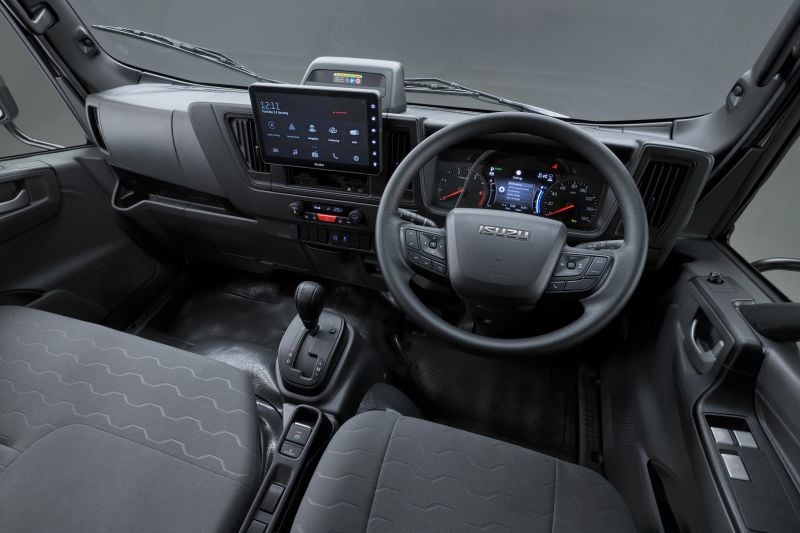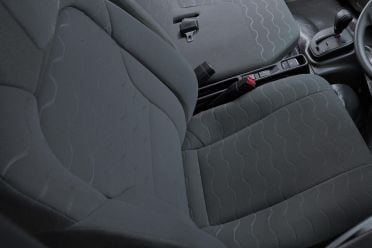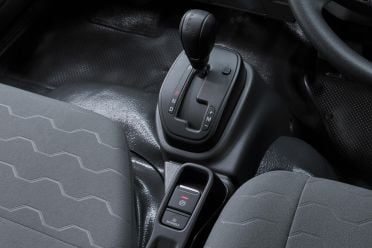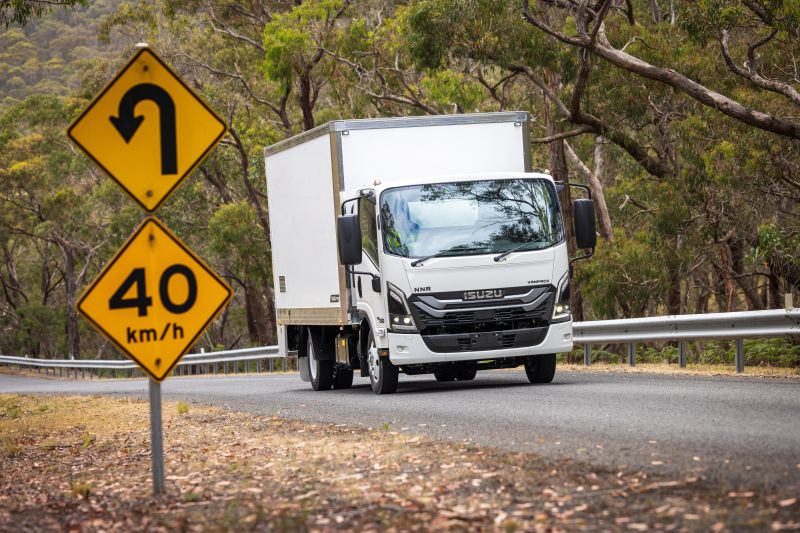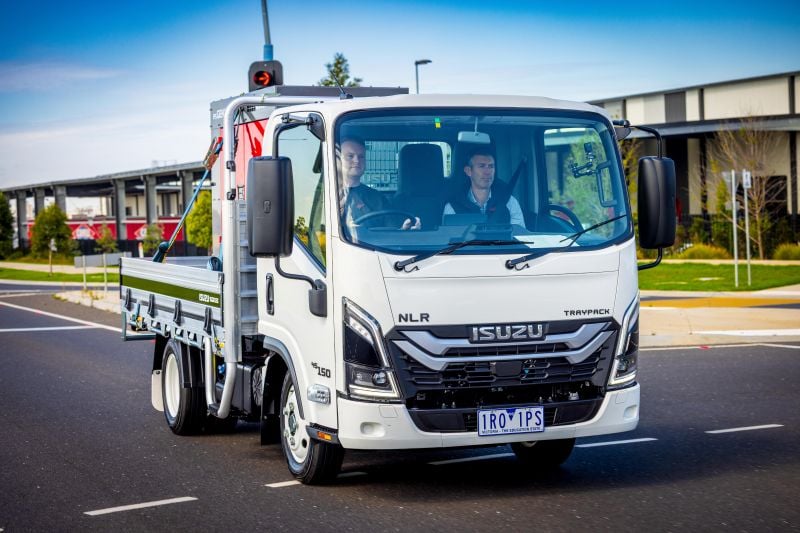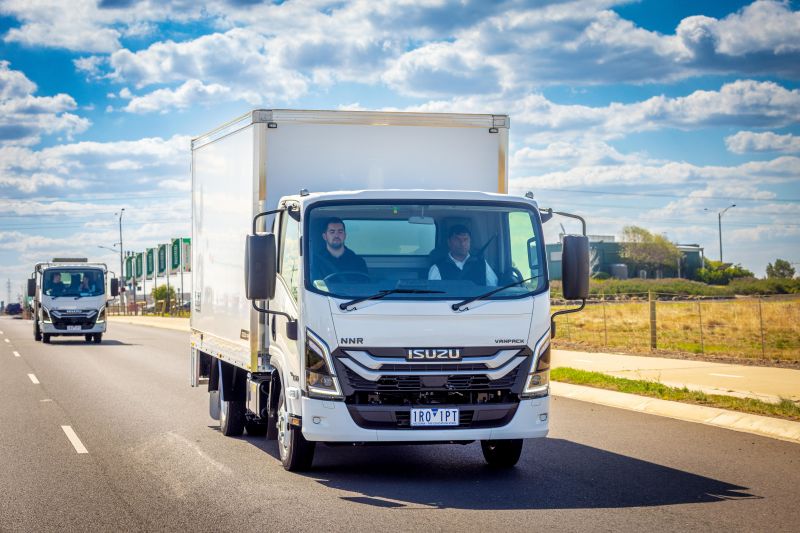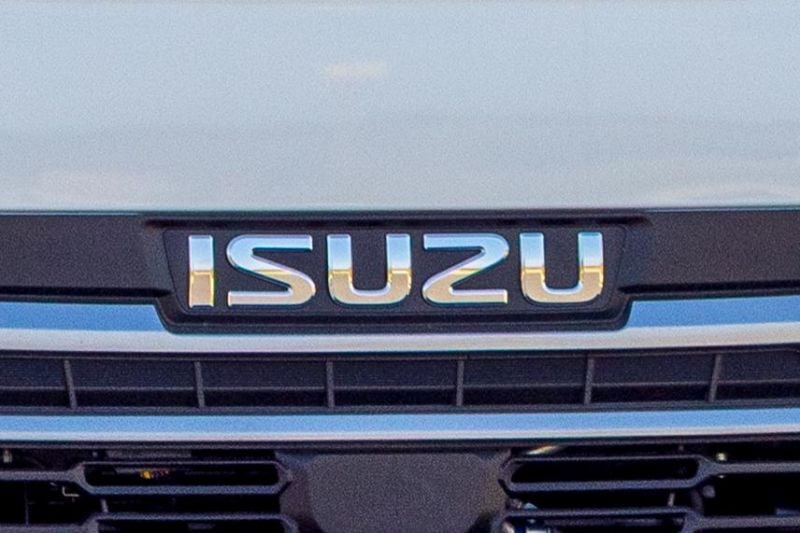Don’t worry. This is still CarExpert and not TruckExpert.
Isuzu is currently in the process of launching a new-generation version of its smallest truck on offer locally, the N Series (aka the Elf in Japan).
While you do need a heavy vehicle license to drive many versions of this truck, almost half of the configurations can be driven with a regular car license. This means it could be a good workhorse option for those who would typically be considering a traditional dual-cab ute.
Truck model lifecycles are considerably longer than they are for cars. The current, sixth-generation N Series was introduced back in the late 2000s and has been around since then with incremental updates.
With this new, seventh-generation model, Isuzu has made a considerable amount of changes. On the outside, there’s revised styling and new LED headlights across the range.
Inside, there’s a more car-like interior with a smaller steering wheel that now features buttons, and a revised gauge cluster setup that now includes a larger digital instrument cluster, as well as an electric park brake with an auto-hold function, among other upgrades.
WATCH: Paul’s video review of the 2024 Isuzu N Series truck
Under the skin, all the powertrain options are now Euro 6 emissions-compliant, which means they now require AdBlue. The 3.0-litre four-cylinder turbo-diesel variants now also get the option of a nine-speed dual-clutch automatic transmission, instead of an automated manual transmission.
Lastly, there has been a major upgrade to the safety technology. Thanks to a new stereo camera setup, the safety systems now have higher quality camera feeds and a wider field of view. There’s also new safety equipment such as front cross-traffic alert and adaptive cruise control, depending on the variant, among others.
Ahead of first customer deliveries commencing later this year, we got a chance to drive two pre-production versions of the N Series truck, the NLR 45-150 DT D25 Traypack and NNR 45-150 DT D34 Vanpack, as part of a media drive.
Is this truck worth considering over a dual-cab ute? Read along to find out.
How much does the Isuzu N Series cost?
Isuzu Australia hasn’t confirmed the pricing for the new-generation N Series truck just yet.
However, the current N Series truck range starts at $54,843 before on-roads for the NLR 45-150 SWB Traypack, and extends to $99,594 before on-roads for the NPR 45/55-155 AMT SWB Servicepack.
What is the Isuzu N Series like on the inside?
Well, it’s very clearly a truck, but it’s more car-like than ever before.
The new N Series truck it now gets proximity entry. You no longer need to fish the key out of your pocket to unlock it, and can now instead unlock and lock the truck by pressing a button on the door handle.
There’s a heavy-duty side step to help you hop in, because it’s a fair hike into the cabin. There are also hefty grab handles that make ingress and egress much easier. You’d be lost without them.
Once you’re in, the forward and sideward views are impeccable. You sit up very perched, so it’s a commanding place to be, and it feels very far removed from any car-like driving position.
The driver’s seat looks very similar to what the D-Max has, but it’s a suspended unit that bobs up and down when you hit bumps. This is a pretty standard feature for trucks and buses, and it’ll likely feel weird if you’ve only ever driven cars. But it’s very handy and you do get used to it after a while.
Unsurprisingly, the driver’s seat only has manual adjustment. You’re able to dial in a comfortable position, but you wouldn’t want to be much taller than six-foot tall because the space on offer could feel a little cramped.
The pedals are also positioned too high. In order to press the brake pedal, I had to lift my foot off the ground, which after a while made my ankle ache.
I appreciate that the steering column has both tilt and reach adjustment. However, the steering column itself plunges under the floor between the driver’s feet, meaning foot room is compromised. This is yet another classic truck trait and something that’ll likely take some adjusting to.
Compared to the outgoing model, the steering wheel itself is more car-like than ever. It’s smaller, but it still feels like you’re steering a truck with the way it’s angled. Plus, it doesn’t help that the wheel itself is plastic, so it doesn’t feel very premium.
There are also buttons on the steering wheel for adjusting the media and cruise control, among other functions. The outgoing model doesn’t feature any steering wheel buttons at all, so this is a major upgrade that makes the truck feel much more modern.
Behind the steering wheel is still a set of analogue dials for the engine and road speeds. They’re large, clear and easy to read. There’s a small multi-information display sandwiched between the tacho and speedo dials, which can cycle through a range of informative pages. It’d be great if there was one for a digital speedometer.
Moving across, while there have been many changes to the N Series’ interior, something that hasn’t changed is the 10.1-inch touchscreen infotainment system. It still looks rather aftermarket in the way it’s plonked on the dashboard.
We didn’t get time to dive too deeply into the menus, but on the surface level, it appears easy to navigate and hard to get lost in. The system offers both wired versions of Apple CarPlay and Android Auto, as well as satellite navigation.
Looking around the cabin, this is a through-and-through commercial vehicle with workhorse intentions. Don’t go expecting to see any plush soft finishes in here. Instead, there’s hard, scratchy plastic everywhere, which will wear better in the long run.
Other key changes around the cabin include a new climate control pod, which thankfully retains physical dials, as well as a new automatic gear shifter, plus an electric park brake with an auto hold function. The latter feels so strange in such a heavy-duty vehicle, but it does make life much easier and also frees up more space for storage.
Speaking of storage, there is enough, but more would be nice. From large netted sections above the driver’s head to a fold-down section where the middle seat goes, you’ll easily be able to find a space for pens and paper.
On the passenger side, there’s a two-person bench seat, which is far from the most glamorous space ever, and it’s a fixed unit as standard.
Beyond this, there’s not much else to the cabin. You can get a crew-cab version of the N Series, which increases total seating capacity to six. Updated versions now get an air-conditioning unit with vents in the back so rear occupants can stay cool.
What’s under the bonnet?
Both the N Series trucks we drove were powered by the 3.0-litre four-cylinder turbo-diesel engine, mated with the new nine-speed dual-clutch automatic transmission.
| Specifications | Isuzu NLR 45-150 SWB | Isuzu NNR 45-150 MWB |
|---|---|---|
| Engine | 3.0L 4cyl turbo-diesel | 3.0L 4cyl turbo-diesel |
| Power | 110kW @ 2800rpm | 110kW @ 2800rpm |
| Torque | 375Nm @ 1280-2800rpm | 375Nm @ 1280-2800rpm |
| Transmission | 9-speed DCT | 9-speed DCT |
| Drive type | RWD | RWD |
| Fuel tank | 75L (diesel) 14L (AdBlue) |
100L (diesel) 14L (AdBlue) |
| Weight | TBC | TBC |
| Payload | TBC | TBC |
| Braked towing capacity | 4000kg | 4500kg |
| Gross vehicle mass (GVM) | 4500kg | 4500kg |
| Gross combination mass (GCM) | 8000kg | 8000kg |
How does the Isuzu N Series drive?
To start up this truck, you no longer need to put the key into the ignition. Instead, you just need to have the key fob nearby and twist the starter knub where the key was previously inserted.
Once you do this, the 4JZ1 four-cylinder turbo-diesel engine comes to life in a similar way to the 4JJ3 engine in the D-Max and MU-X. It’s far from the most refined engine at idle, but at the end of the day this is a commercial vehicle built for heavy-duty work.
To set off, you need to use the substantial-feeling automatic gear selector. It defaults to the ‘Eco’ drive mode every time you turn the truck on to minimise fuel consumption, but thankfully you can easily switch this off by pressing a button near the gear shifter.
Also, if you forget to turn off the electric park brake, it deactivates automatically as you set off.
Initial acceleration in this truck won’t blow your socks off by any means, but you’ll keep up with other traffic provided you don’t have too much weight on board. Plant your foot, however, and the engine just revs out and doesn’t accelerate any faster.
Both trucks we sampled during our brief drive loop featured the standard-output version of the 4JZ1 engine, which produces 110kW and 375Nm. This isn’t very much at all, but for the majority of purposes you won’t feel like you need much more.
The N Series can also be had with a more powerful version of this 3.0-litre turbo-diesel that produces 129kW and 430Nm, which is more in line with what the 3.0-litre engine in the D-Max and MU-X produces.
If you’re power-hungry, this might be worth opting for instead, at the expense of fuel consumption. We were unable to record an economy figure and because it’s a truck Isuzu doesn’t claim one either.
What’s interesting about this new-generation truck is that automatic versions now get a nine-speed dual-clutch automatic instead of an antiquated automated manual transmission. To sum it up, it feels so much more modern and in line with what we expect from dual-cab utes in terms of performance.
The gearshifts feel snappy and almost instantaneous. Plus, there’s no drop-off in momentum, which is great if you’re hauling heavier equipment.
Having more gear ratios means the truck can stay within its torque band more easily, delivering more consistent acceleration.
One downside, however, is that the truck frequently chooses the highest gear possible to minimise fuel consumption. When you call for more acceleration, it can occasionally lag before dropping one, two, or even three gears to get things moving along faster.
Driving around town in the N Series, it feels very much like a truck. It bobs and rocks with the bumps, even with a bit of weight in the back. Having the seat suspension does help with this though.
Although you do need to work the steering wheel, this truck feels nimble. Its turning circle also feels notably smaller than dual-cab utes, which is a plus if you frequently drive in built-up areas where three-point turns are necessary.
There was a noticeable difference in the ride quality of the two trucks we drove. The NLR has independent coil front suspension, which makes it feel more car-like and more willing to lean in bends. The NNR, on the other hand, has leaf suspension at the front, which is more heavy-duty but makes it feel stiffer and more rigid.
While you’d think these trucks would be quite intimidating to drive, the reality is quite different. You have great outward visibility, plus there are humongous side mirrors, which are great for keeping an eye on what’s happening on either side of the vehicle.
Certain versions of the N Series also come with a reversing camera. However, all variants come with a reversing beeper, which was a fun novelty for a car guy like me, but after a while I can imagine it gets annoying.
Building up the speed, the engine does start to run out of puff. Even cruising along flatter ground, it’ll frequently hover around two or three gears, which creates an unsettling feeling behind the wheel.
There’s also a fair bit of wind noise that emanates into the cabin. It doesn’t help that the truck is a literal box on wheels, and the side mirrors stick out a fair way.
We didn’t get a chance to drive the N Series out on the highway, but automatic versions have an adaptive cruise control system that works at all speeds. In order to ensure the system works, you need to have the engine brake turned off.
There have been many upgrades on the safety front and this also makes this truck feel more car-like. There’s autonomous emergency braking, lane departure warning, front cross-traffic alert, and traffic sign recognition. A lot of these systems use a new stereo camera setup that’s not only higher-resolution but has a wider field of view.
Lastly, all versions of the N Series now have LED headlights that are bright and clear, providing better visibility at nighttime.
What do you get?
The Isuzu N Series is set to be available in no less than 153 different configurations.
2025 Isuzu N Series equipment highlights:
- Bi-LED headlights
- LED tail-lights
- Keyless entry and push-button start
- Intermittent window wipers
- Multi-information display
- 10.1-inch touchscreen infotainment system
- AM/FM/DAB+ radio
- Wired Apple CarPlay and Android Auto
- Satellite navigation
- 32GB internal storage
- Climate control
- LED interior lamp
- Electric park brake
- Driver’s bucket seat with mechanical suspension
- Two-person bench seat
Is the Isuzu N Series safe?
Given that the Isuzu N Series is a truck, it hasn’t been crash-tested by ANCAP.
Standard safety equipment:
- Two airbags
- Autonomous emergency braking (AEB)
- Intersection AEB
- Front cross-traffic alert
- Lane departure warning
- Attention alert system
- Misacceleration mitigation
- Traffic movement warning
- Traffic sign recognition
- Adaptive cruise control (automatic only)
How much does the Isuzu N Series cost to run?
The Isuzu N Series’ chassis is covered by a six-year, 250,000km warranty, whereas the genuine parts and accessories are covered by a three-year warranty.
| Servicing and Warranty | Isuzu N Series |
|---|---|
| Warranty | 6 years, 250,000km (chassis) 3 years (genuine parts and accessories) |
| Roadside assistance | 6 years |
| Service intervals | 12 months or 25,000km or 500 hours |
Isuzu offers a range of service packages, though it doesn’t list what these cost.
CarExpert’s Take on the Isuzu N Series
If you’re someone who is constantly hauling around heaps of tools and also needs to tow a heavy trailer, you’d be silly not to consider something like this.
Many people buy utes as they are marketed as the type of vehicle you can use for work during the week and then go out adventuring on the weekend. However, this also means they aren’t really the masters of anything.
This is where the Isuzu N Series comes in. It’s purpose-built as a hardworking workhorse that, depending on the configuration, can tow 4500kg and still offer around 1500kg of payload. And a number of variants can be driven on a car licence.
The downside is you can’t go expecting this truck to drive just like a car. The driving position is much more upright, there are acres of harsh plastics in the cabin, and the infotainment still doesn’t match the benchmark of what’s offered in cars. It’s much more rudimentary and focused on heavy-duty work.
It doesn’t help that the 3.0-litre four-cylinder turbo-diesel engine in the trucks we drove felt a little sluggish and had to be worked hard out on the open road. The nine-speed dual-clutch automatic, however, is snappy and a fantastic addition to this package.
Despite my gripes, this truck feels more agile than many dual-cab utes and has a smaller turning circle. This can make a big difference if you spend a lot of time in the city.
Another major consideration is that the N Series is considerably cheaper than many dual-cab utes and American pickups. For budget-conscious tradies and business owners, opting for a truck like this can make a lot of sense from a cost of ownership perspective.
Isuzu has put a lot of effort into updating this truck, and it’s clear it’ll attract a much wider audience when it arrives locally later this year. Watch this space.
Click the images for the full gallery
MORE: Everything Isuzu




